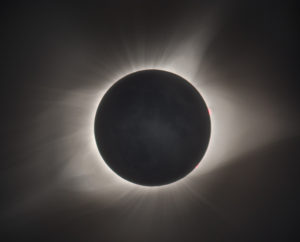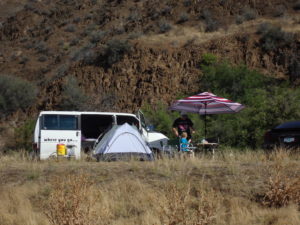On the morning of August 21, RoZ and I were in Service Creek, Oregon for the total solar eclipse. We were with our friend Sage, his 8-year-old son Cosmo and their greyhound Serendipity.
We had driven 300+ miles from Seattle the day before and camped on the roadside near an old back-country stage stop. After marveling at the high-desert skyscape, we got a good night’s sleep and had breakfast at the stage stop in time for the big event.
The early and middle parts of the partial phase were familiar. Edges of shadows get sharper, and looking at the sunlit landscape is gentler on the eyes. But in the minutes before totality, things started to feel weird. Even though we were bathed in sunlight, it suddenly felt as cool as it was the night before.
We heard a voice in the area call out, “two minutes,” and later, “one minute.” The light became obviously dim, and it began to flicker.
This is when the adrenaline kicked in. Our minds knew what was going on. But feeling the sunlight dim so suddenly defies reality, and my reptilian brain reacted. Thru the welding glass I watched the last sliver of sunlight disappear, and I pulled the glass away to see a sprawling star with a hole in it.
A collective gasp went up among our fellow travelers at the roadside. It was dark, but more like late twilight than midnight (after all, the sun was still shining about twenty miles away). I could see a handful of bright stars, but not enough to recognize any constellations.
We were struck most by how star-like the corona appeared. We know in our minds that the sun is a star, but this experience allowed us to know that in our hearts. Most photographs of a total eclipse only capture a fraction of the complex structure of the corona sprawling in all directions from the sun itself.
I snapped a few photos with our digital SLR, knowing it was futile. After a peek thru the binoculars I quickly passed them on. We could all see a deep orange area off the upper edge of the Moon, but by the time I could get another close look I saw the diamond ring of returning sunlight and heard myself calling out, “Diamond ring, glasses on!”
The sunlight came back and there were hugs and joyful tears. My words at the time were “overwhelmed and overcome” mixed with a dose of giddiness. I felt like a kid who had just survived an intense thrill-ride wanting to say, “let’s do that again!”
I now understand why people become addicted to this. A total eclipse is not something you see, it’s something you experience. No one walks away from this experience and says, “meh.” No one walks away regretting the time and effort it took to get into position. Everyone walks away with the image of the sun’s corona – and their emotional reaction to it – etched into their core forever.
Eclipse traffic
The eclipse was a late-morning event, and since we are not morning people, our plan was to get into position the night before and camp there. In the weeks leading up to our trip, I spent a lot of time scouting locations with this awesome Google map. The idea was to find a spot with clear skies, minimal traffic, and high tolerance to roadside camping.
Coastal Oregon had too much potential for fog and low clouds. The Willamette Valley (Salem, Albany, Corvallis, etc.) was likely to be sunny but crowded (Friends in Corvallis sent links to local news stories about apocalyptic gridlock, and of being advised to prepare as if for a natural disaster). In the rain shadow of the Cascades, the town of Madras looked like an optimum spot: clear skies and a magnificent view of the darkening Mt. Jefferson. Unfortunately, too many other people had the same idea. Madras was madness.
I looked further east and liked the layout of the riverbanks near Service Creek. We could avoid the I-5 corridor by taking I-90 to US-97, and then back roads to avoid the Madras madness. At first Sage (who had a long-planned beach party on Saturday) suggested we go to “the closest place within the path,” so we looked at points east of Salem. As fears of traffic Armageddon spread, he agreed at the last minute that my “back door” plan was a good idea after all.
As we drove out of Seattle on Sunday afternoon, the only traffic we saw was going in the opposite direction.
In Biggs Junction, OR, our gas station attendant asked, “are you heading south?” “Yes.” “Well, enjoy the circus.”
We watched the sun set behind Mt. Hood as we drove along the high desert ridge-tops. We saw thousands of wind turbines just as the red flashing lights activated on the tops of their towers. They flashed in sync with each other. From one vantage point, it looked like an entire city of red lights was blinking in unison.
Occasionally we’d encounter another vehicle on its way to the eclipse zone, but we encountered no traffic whatsoever on our way to Service Creek. At about ten o’clock we parked in a roadside pull-out that I expected to be packed by then. Sage and I walked toward the store to make sure it was OK to park and camp there and met the owners – Randy and Linda – just as they were about to go home at the end of a long day (“We’ve been here since 7 this morning.”)
They had hoped to allow camping on the grassy area between the parking area and the creek, but the local authorities wouldn’t allow it. Self-contained vehicles were OK, but our plan to pitch a tent would attract attention. They suggested some camping/fishing areas a few miles down the road.
Before we got back to the van, they’d changed their minds. We could parallel-park the van, and pitch the tent on the grass behind it. The tent would be hiding behind the van, and if anyone asks we could tell them that Randy and Linda gave us permission to camp there. (Sage: “I didn’t need to bring my cook stove, ’cause we’re gonna have breakfast in their cafe tomorrow morning.”)
Sage and Cos slept in the van while RoZ and I slept in the tent. Before dawn, we heard steady traffic on the road. We emerged from our tent to find both sides of the road packed with parked cars. I could hear a neighbor reciting our timetable for the eclipse. The partial phase didn’t start for another hour, which was just enough time for breakfast.
Traffic was more of an issue on the return trip, but we avoided the worst of it.
Totality had barely finished when cars started leaving, kinda the way a theatre empties out as soon as the closing credits start to roll.
We savored the experience and waited for partiality to end before breaking camp, then we spent much of the afternoon frolicking in the river nearby. It was after 5 when we started back. Traffic was heavy but not enough to slow us down (our long and frequent stops did that).
In Wasco we joined US 97 and those leaving the Madras madness. The ten miles from Wasco to Biggs Junction was the parking lot we were warned about. Like many other travelers, we were forced to take an unscheduled roadside break because the dog couldn’t wait any longer.
We had planned to follow the Washington side of the Columbia River to I-5 for the trip back to Seattle, but darkness and traffic reports (northbound I-5 was gridlocked for 150 miles) convinced us to retrace our route from the day before. There was a short burst of gridlock on the Washington side of the US 97 bridge, but after a few miles it was clear sailing.
So all-in-all, our traffic avoidance plan succeeded due to tried-and-true strategies: Arrive early, stay late, and follow the Roads Less Travelled.
Random yuks
• On Sunday night we were sitting in our lawn chairs gazing at the Milky Way, and a guy went wandering by looking for a port-a-potty. We said there wasn’t one around, and tactfully asked what type of port-a-potty usage he needed. It was only a “number one” and he continued on his quest. When we saw him wandering back, Sage asked if “everything came out all right,” and his answer cracked us up: “I finally found something sufficiently important to pee on.”
His name was Teddy, and we invited him to sit with us. Teddy fashioned a pinhole viewer from a cylindrical potato chip can while he and Sage pondered the ideal energy drink. Teddy: “What do I do with all these chips?” Sage: “I’ve got an eight-year-old boy on board who would LOVE those.”
• Cos likes to play a word game. He announces a word’s first letter along with some hint, and our mission was to guess the word. In the afterglow of totality, he asked Sage and RoZ to guess a word that begins with ‘e’ and has to do with space. RoZ’s first guess was “Earth”, followed by “Enterprise” (as in the starship). Good guesses, but no cigar.
I came wandering into the conversation and said, “Eclipse, duh.” Cos agreed. “Duh!”






We took the kids to Mazatlan for the best eclipse (duration and location) of the late 20th century in the summer of 1991. Cloudy where we went to view it. (Back at our hotel everyone said they saw it right there.) Between life’s twists and turns and the limits of limited incomes and imaginations, we never planned for another totality trip until 2017. Actually, as I anticipated it for years in advance, my one worry was, “The rightists are so fanatical and the Democrats are so feckless, what if the Republicans get back into power in the 2016 election? Could we truly enjoy a solar eclipse that was itself eclipsed by the nightmare of high-tech fascism?”
It was a depressing thought, and I never could shake it. Certainly I never believed that H. R. Clinton could be elected–everything about her campaign felt like the reincarnation of overconfident Thomas Dewey in 1948.
And so it came about.
Daunted & depressed by the fatal subversion of American democracy, and the inevitable planetary catastrophe we’re fated to confront, nevertheless we decided to take the gamble again, as the calendar inexorably worked closer to the pre-determined date. We drove westward from St. Paul, to seek a likely sunny-sky spot. Our destination turned out to be Beaver Dick county park in southeastern Idaho. The forest-fire smoke blew away overnight, the scattered clouds evaporated, and the 150 spectators were in the right place and the right time for the cosmic thrill.
I’m sure we were the largest assemblage of rational, scientifically-educated
people ever seen in Rexburg, Idaho. 95% were from out of the state, including astronomy clubs from Japan, England, Germany, and other lands.
I enjoyed reading about your eclipse excursion. Next chance in North America will be in 2024. We’ll have lunar eclipses before then (maybe one this month?) but they just don’t compare. When you EXPERIENCE the totality, and contemplate its implications about the utter impersonality and the immensity of the solar system & universe, then at least we have the consolation of philosophy to provide a perspective on our insignificance. The painful, pitiful peril that we are so inextricably being dragged into, with mass extinctions, starvation, thirst, collapsing civilizations, madmen in command, and planetary fear and misery—will come to its pathetic end, while just as predictably the planets and their satellites will perform their gravitational paces through space-time, waiting for the cockroaches and other insects to evolve enough to the point where they in their turn become conscious of the celestial theater of a Solar Eclipse on Terra.